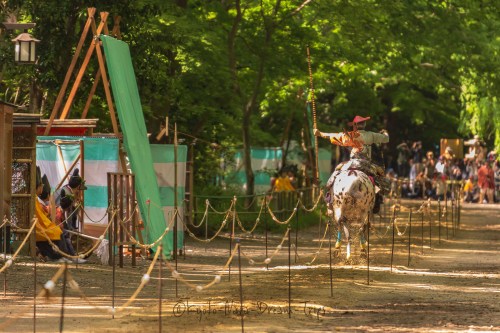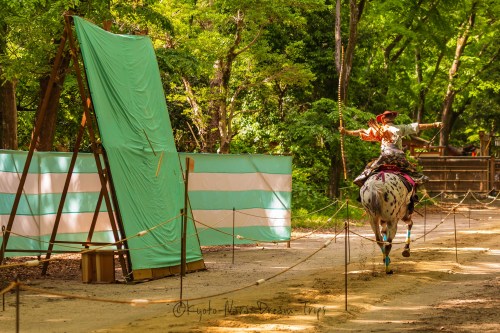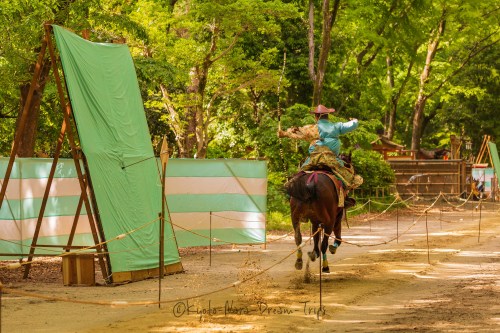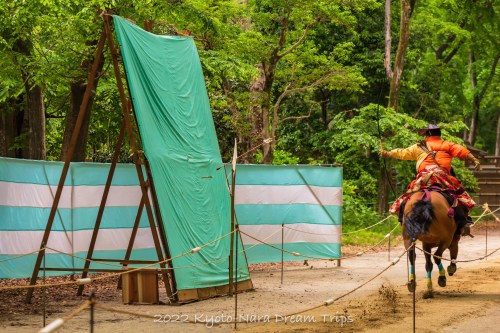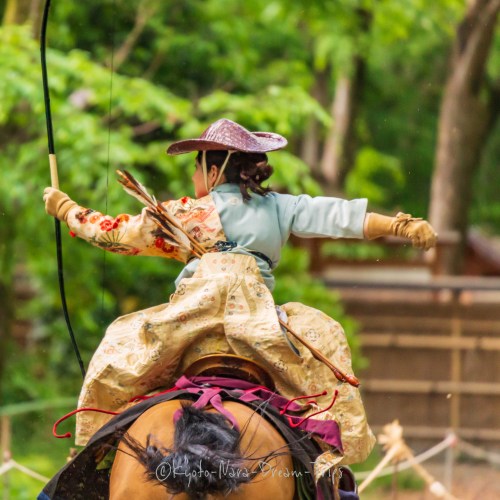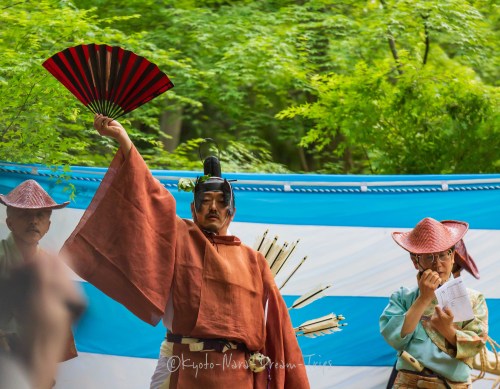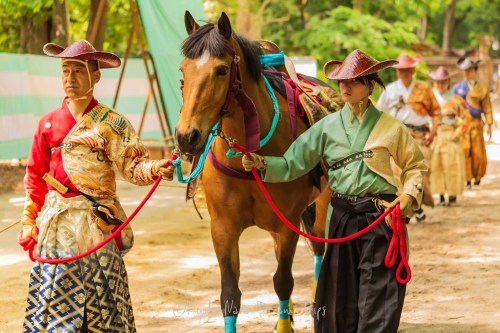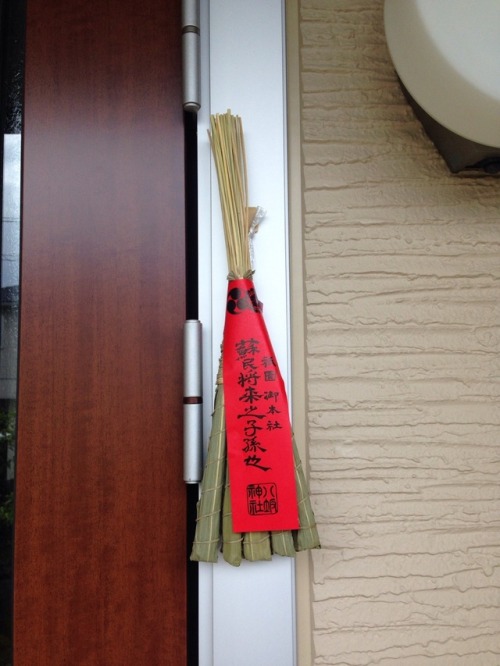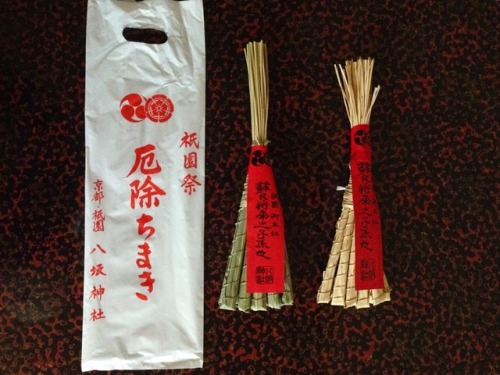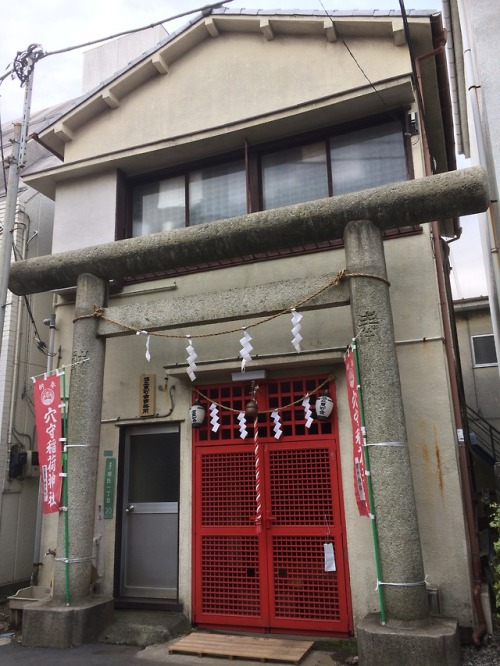#shinto
The riders are fully dressed as samurai warriors during the Yabusame Shinji. They wear a costume comprising of a cloak (sokutai), a bracer or arm guard (mukabaki), gloves, fur chaps (mukabaki), shooting shoes (kanokutsu); he carries a long sword (tachi) and short sword (koshigatana), a quiver of arrows (ebira) on his back, and has a bound wisteria bow (shigedō).
Post link
The riders are fully dressed as samurai warriors during the Yabusame Shinji. They wear a costume comprising of a cloak (sokutai), a bracer or arm guard (mukabaki), gloves, fur chaps (mukabaki), shooting shoes (kanokutsu); he carries a long sword (tachi) and short sword (koshigatana), a quiver of arrows (ebira) on his back, and has a bound wisteria bow (shigedō).
Post link
The riders are fully dressed as samurai warriors during the Yabusame Shinji. They wear a costume comprising of a cloak (sokutai), a bracer or arm guard (mukabaki), gloves, fur chaps (mukabaki), shooting shoes (kanokutsu); he carries a long sword (tachi) and short sword (koshigatana), a quiver of arrows (ebira) on his back, and has a bound wisteria bow (shigedō).
Post link
The riders are fully dressed as samurai warriors during the Yabusame Shinji. They wear a costume comprising of a cloak (sokutai), a bracer or arm guard (mukabaki), gloves, fur chaps (mukabaki), shooting shoes (kanokutsu); he carries a long sword (tachi) and short sword (koshigatana), a quiver of arrows (ebira) on his back, and has a bound wisteria bow (shigedō).
Post link
The riders are fully dressed as samurai warriors during the Yabusame Shinji. They wear a costume comprising of a cloak (sokutai), a bracer or arm guard (mukabaki), gloves, fur chaps (mukabaki), shooting shoes (kanokutsu); he carries a long sword (tachi) and short sword (koshigatana), a quiver of arrows (ebira) on his back, and has a bound wisteria bow (shigedō).
Post link
The riders are fully dressed as samurai warriors during the Yabusame Shinji. They wear a costume comprising of a cloak (sokutai), a bracer or arm guard (mukabaki), gloves, fur chaps (mukabaki), shooting shoes (kanokutsu); he carries a long sword (tachi) and short sword (koshigatana), a quiver of arrows (ebira) on his back, and has a bound wisteria bow (shigedō).
Post link
The riders are fully dressed as samurai warriors during the Yabusame Shinji. They wear a costume comprising of a cloak (sokutai), a bracer or arm guard (mukabaki), gloves, fur chaps (mukabaki), shooting shoes (kanokutsu); he carries a long sword (tachi) and short sword (koshigatana), a quiver of arrows (ebira) on his back, and has a bound wisteria bow (shigedō).
Post link
Various pictures of the participants of the annual “Yabusame Matsuri” at Shimogamo jinja in Kyoto City, Japan.
Post link
Various pictures of the participants of the annual “Yabusame Matsuri” at Shimogamo jinja in Kyoto City, Japan.
Post link
Various pictures of the participants of the annual “Yabusame Matsuri” at Shimogamo jinja in Kyoto City, Japan.
Post link
Yasaka shrine’s chimaki, a charm for warding off evil (made of only rice reeds and no rice cake inside unlike sweets sold in May). It’s deadly awful, hot and wet July and the arrival of Gion Festival in Kyoto.
Few days ago after celebrating my mom’s birthday at some ryotei (authentic Japanese restaurant) around Higashiyama, I dropped in Yasaka shrine for receiving this year’s new chimaki (you use the word “receive (from god)” instead of “buy” in Japanese for charms and amulets of shrine). Yasaka shrine’s chimaki is sold during the entire month of July and relatively easy to obtain compared to Yama and Hoko floats’, though every float, built and exhibited on the street, starts selling its original chimaki only a few days before the parade day and sells out quickly.
Chimaki will be hanged out at the porch or the gate. The protection lasts for a year and you will take it back to any shrine after a year: since it’s a holy item Shinto priests burn old charms with praying. Appreciate for the protection of the past one year, and wish for another one-year mercy.
Chimaki of Gion Festival
https://www2.city.kyoto.lg.jp/koho/eng/preview/40.html
Strip color and letters differ by float. Yasaka shrine’s is to ward off evil but every chimaki’s mercy differs by float, such as for romantic love, study, and money profit.
Folklore on Somin Shorai
https://en.m.wikipedia.org/wiki/Somin_Shorai
The red strip on Yasaka shrine’s chimaki reads “A Somin Shorai’s descendant”.
Gion Festival
https://en.m.wikipedia.org/wiki/Gion_Matsuri
八阪神社の厄除ちまき(お菓子ではなく中は空)。時は蒸暑くも不快極まりない七月、祇園祭の到来である。
先日東山の料亭で母の誕生日を祝った後、八阪神社へ寄り今年のちまきを受けた(ちまきは「買う」ではなく「受ける」「授かる」)。街中に建つ祇園祭の山鉾のちまきは巡行日の2、3日前から売りに出され、すぐに売切れてしまうが、八阪神社のちまきは山鉾と違い7月中売られており手に入りやすい。
ちまきは玄関の外か門の前に掲げる。御利益は一年間。1年過ぎたらお焚き上げのため神社へ返す。一年間の御守護に感謝。また一年間御加護が有りますように。
ちまきとは
http://www.kyotodeasobo.com/gion/chimaki/
八坂神社の厄除けである蘇民将来の謂われについて。八阪神社のちまきには「蘇民将来子孫也」と書かれた赤い紙が付いている。また山鉾ごとのちまきの御利益一覧表など。縁結びの保昌山(ほうしょうやま)は女子に大人気で毎年速攻売り切れる。筆者も恋する女子友に購入に付き合わされたことが(長蛇の列に並んだ)。
祇園祭
https://ja.m.wikipedia.org/wiki/祇園祭
https://www.kyokanko.or.jp/gion/gyoji.html
Post link
Shirahige shrine’s “Great Torii in the Lake”, Lake Biwa, Shiga prefecture. The hall is located back on the land. The head shrine of all Shirahige (literally means “white beards”) shrines in Japan as well as the oldest shrine in Ohmi (old name of the area around Lake Biwa).
…I carelessly caught a partial figure of my friend at last.
滋賀県琵琶湖畔、白髭神社湖中大鳥居。社殿は背後陸地にある。白髭神社の総本宮ならびに近江最古の大社。
・・・最後に友達の姿がちょろっと入ってしまった。
白髭神社
https://ja.m.wikipedia.org/wiki/白鬚神社
http://shirahigejinja.com
おはらい町 - oharai-machi
A small community providing food and other amenities to pilgrims and visitors of the inner shrine of Ise 内宮 - naikuu. Eerything looks like old edo-style stuff but in fact, most buildings are post-meiji, still its a very charming, yet pseudo-historical small town just in front of Japan’s most sacred land, the inner shrine of the grand shrine of Ise - 伊勢神宮内宮 in 三重県 Mie prefecture.
Post link
穴守稲荷神社 (東京都練馬区旭丘1-20-5)
Anamori Inari Shrine (1-20-5 Asahigaoka, Nerima, Tokyo)
I stumbled across this unusual shrine while biking from Ikebukuro to Nerima. I’ve never seen a shrine built into a house (and a somewhat modern house at that). After researching the name Anamori Inari Shrine, I found that there is a quite large and famous Anamori Inari Shrine in Ota ward, and that this house serves as a local branch office with an extremely small shrine attached to the front.
This has got to be the strangest shrine I have encountered to date. Has anyone else ever seen a shrine like this?
Post link

